

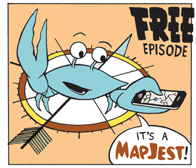

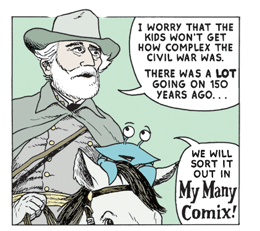

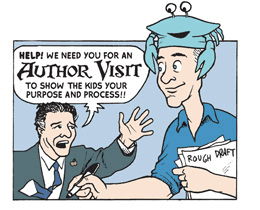

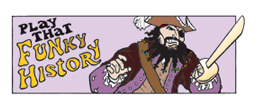

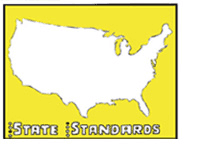


|
|

|
 |
||
 |
"Thank you so much for your comix. They arrived Friday and Andrew has been devouring them." Brooke, mother |
|
|
|
||
Archive for the ‘History Teacher’ Category
Stumpers
Written on Wednesday, April 30th, 2008 [permanent link]April has been a busy month of driving, speaking and drawing. It’s the high season for my Author’s Purpose talks and SOL review speeches. The students I’ve seen have been bright and engaged — last night I met one who even knew what the War of Jenkins’ Ear was!!! He was in a group of fifth-graders from California visiting Williamsburg, and I couldn’t stump them in my Hysterical History talk no matter how I tried.
But students in an earlier group stumped ME. One asked what the root of the slang term “Yankee” was — and I fumbled around the answer (I was in the neighborhood, but not knocking on the front door). Here’s the real answer: “Yankee” goes all the way back to 1683, when the Dutch were in control of what we now call New York City. It’s a not-so-nice term they used for the English colonists in neighboring Connecticut. It may be from Dutch word Janke, meaning “Little John.” In one college class I studied how groups that get insulted chose to use that insult as a brand of pride, and this may be a great example of that kind of recycled use. “Yankee” may also be a form of the Dutch nickname Jan Kees, after “John Cheese,” the generic nickname the Flemings slapped on Dutchmen. So the Dutch took an insult at them and then turned it onto the English — who then took it as a proud description for themselves! It’s a general term for “native of New England” by 1765. Of course, during the American Revolution the British in London used it as a slur for all Americans, but look at how that one turned out.
In that same group of students, I was asked why the Pentagon headquarters of the U.S. Department of Defense has five sides. NO CLUE!!! Turns out we got a striking building just because of a striking need — it’s a great story of American can-do-in-a-hurry. The Pentagon was built quickly because of the need for office space to run the American military effort in World War II. It has 3,705,793 square feet, making it one of the largest office buildings in the world. The first site planned for it was beside Memorial Drive, and an early plan called for a square structure with one corner cut off to fit it by an existing road. This produced a skewed Pentagon shape — five sides but not balanced or pleasing to the eye. With further planning, the building got moved to a larger plot of land nearby, and that allowed the project’s chief architects, George Edwin Bergstrom and David J. Witmer, to refine the five sides into the form of a true pentagon — which actually allows for easy movement around the huge building and for the most sunlight possible to enter the building. Preliminary design and drafting took just 34 days — and resulted in the happy accident of a world-famous shape.
I love it when History and geometry come together!
Tags: Bentley Boyd, Chester the Crab, comix, history, Pentagon, Yankee
Posted in History Teacher | 1 Comment »
No Crab Left Behind!
Written on Friday, March 28th, 2008 [permanent link]U.S. Education Secretary Margaret Spellings was in Virginia this week on her never-ending road tour to keep the No Child Left Behind federal program alive. Congress has been debating its renewal for a year now, and Spellings has the lonely task of defending this lightning rod law.
We all want students to read at a level appropriate to their age. We all want them to be able to do math. The trouble with No Child Left Behind is that – as many state education laws had done before it – it passed requirements without giving the neediest schools enough money and resources to attack the problem. What federal money there was shifted to reading and math intervention, naturally, which also meant school systems dropped classroom time and budgets for subjects like history. If you compare state testing items from 1999 and 2008 you’ll see that many states simply dropped social studies curriculum off the exams. Not a great way to build the next generation of informed citizens.
A lot of states are rethinking this power grab by the federal government. No Child Left Behind is an odd push for a “conservative” White House that allegedly doesn’t believe in big government. Virginia is one of several states where lawmakers have said they won’t participate in NCLB if they and the feds can’t agree on the standards and the way they are tested. It was revealing that when Spellings came to Richmond this week she used the federal money as one of her main reasons to stay with NCLB. The state got $352 million in fiscal 2007 from the feds, and she warned it would not be good for Virginia “to walk away from those federal resources.”
I remember the Reagan administration using the same big government money scare when it wanted states to raise the legal drinking age to 21. And it worked.
I think a renewal of No Child Left Behind should give states more flexibility on their standards. If politicians want schools to be more like businesses, they should recognize that economic choice is pushing us towards an ala carte world. For every McDonalds in the economy there are thousands of local and regional businesses that offer more choice for their local markets.
No Child Left Behind should get more money from the feds with fewer strings attached.
And of course it should include history testing! Thomas Jefferson said we needed an educated citizenry. Boosting reading may boost subscriptions to Sports Illustrated, Vogue or Car and Driver, but we Americans need to keep in touch with the communal politics that hold this nation together. We’re losing that, and No Child Left Behind doesn’t help.
Stay tuned . . .
Tags: Bentley Boyd, Chester the Crab, comix, education, history, No Child Left Behind
Posted in History Teacher | 2 Comments »
Dialogue in Democracy
Written on Monday, December 3rd, 2007 [permanent link]You know a forum on democracy is cool when they include the cartoonists! A few weeks ago PBS gathered about 50 American leaders to Colonial Williamsburg to debate a 21st Century description of American citizenship. Mixed in with the founder of the online Craigslist and the mayor of Youngstown, Ohio, was Pulitzer Prize-winning editorial cartoonist Mike Ramirez and Kansas comic book publisher Alonzo Washington. I wasn’t there as a cartoonist but as a reporter for the Daily Press, where I have worked to varying degrees since 1992.
The three days put air under my feet and ideas in my head. Democracy matters! And these people practiced it with great care and vigor. Sometimes it got heated as they discussed immigration and health care and service to the larger community, but they also did the one thing that seems to be a vanishing skill in our loud media society: they listened to each other.
We live in an age when opinion is bursting out all over, thanks to cell phones and blogs. We’re yakking and yakking. But democracy happens only when we listen and then decide in a group way which is the favored solution to the problem at hand. Some people aiding this conference are pushing hard to exercise democracy in this new century. This session at Colonial Williamsburg will air on PBS early in 2008, but if you or your civics students want to read about it now check out
www.pbs.org/newshour/btp/did2007.html
Extra credit: check out the Center for Deliberative Democracy at Stanford University. Prof. James Fishkin has a new way of political polling that involves online debate and Q-and-A with experts, and he told this CW session that the numbers are clear: the more people learn and study an issue, the more their opinions change! It’s exciting stuff to realize that we the people CAN have the power!
cdd.stanford.edu/
Tags: Bentley Boyd, Center for Deliberative Democracy, Chester Comix, Colonial Williamsburg, history cartoonist
Posted in Colonial Williamsburg, History Teacher | No Comments »


